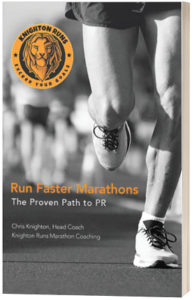Tapering for Peak Marathon Performance
Let your peak fitness emerge on race day by tapering right
Author: Coach Chris Knighton

Disclosure: This article may contain affiliate links. When you buy through links on our site, I may earn an affiliate commission. As an Amazon Associate I earn from qualifying purchases.
The Six Phases Of Marathon Training
- Base Building Phase
- Speed Development Phase
- Race-Specific Quality Phase
- Tapering for Peak Performance <- We will focus on this here.
- Race Day Performance
- Post-Race Recovery
Introduction
The fourth phase of marathon training is called “the taper.”
During the taper, reduce your daily mileage but maintain the frequency and intensity of your runs.
This reduction of mileage allows you to unload the cumulative fatigue you have developed during marathon training. By maintaining the same frequency and intensity of runs during all sessions within the taper, you are able to maintain your day-to-day consistency. This consistency keeps you mentally and physically engaged and eliminates the risks of detraining due to the overall reduction in mileage.
These factors combine to allow you to run faster and further than ever before with a feeling of freshness in your marathon.
The optimal makeup of the taper for each athlete is learned through experience. Some athletes benefit from a longer taper, while others feel stale reducing their mileage for too long and will require a short taper.
Your marathon taper should last 10 to 21 days, depending on your unique needs.
You’ll discover why and how to include a marathon-specific taper in this article.
What is a taper?
The taper is the name given to the period 10 to 21 days before your season’s goal marathon. During the taper, you should intentionally run less to allow yourself the opportunity to freshen up before race day. When done correctly, tapering will cause you to reach your peak level of fitness for a very short window of time. Your goal marathon is then run during this peak window of fitness before any de-training from the mileage reduction can manifest itself within you.
Why taper before an important race?
Tapering for the marathon is essential to achieve optimal performance on race day.
Marathon training works on the principle of cumulative fatigue.
Cumulative fatigue is the idea that throughout marathon training, you are never fully rested between runs. Each run and workout piles on additional stress which is managed but never relieved over the course of training. Every workout, every long run, and every recovery run is done on “tired legs” and is often started with depleted glycogen stores.
The taper allows you to fully relieve the weight of cumulative fatigue and completely top up your energy stores before race day. By reducing daily mileage in the lead-up to your marathon, the fitness you have been developing for the past several months can finally emerge and present itself for a peak performance on race day.
Athletes who do not taper after months of diligent training will likely start their marathon fatigued and low on energy. This is a recipe for disaster which you will avoid after putting into action what you learn in this article.
What does the taper look like?
The optimal makeup of the taper for each athlete is learned through experience. Some athletes benefit from a longer taper, while others feel stale reducing their mileage for too long and will therefore require a short taper.
As a starting point, a 10-day taper can be used for most athletes and you should try a 10-day taper first. The reason for a ten-day taper is that it takes approximately ten days for the benefits of any workout to turn into fitness gains within you. Any workout or long run completed within ten days of a key race is more likely to tire you out than to benefit you physically for race day. Runs performed in the taper period are for building mental confidence and developing freshness only.
Starting ten days before your goal race, reduce the mileage of all of your runs by 50% per run. For example, if you typically run eight miles on Wednesdays, you should run just four miles on Wednesdays in the taper. Keep the same frequency to your runs and complete them at the same intensity (effort level/pace) as normal.
No hard workouts should be done within the taper period, but all running should be run at normal training paces. Any speed work done within this period should be kept short so as to not fatigue you.
This should be a sufficient framework to freshen up most athletes.
However, if based upon your personal experience, a 10-day taper was either too long or too short for your liking, you can modify it in your next season’s taper period. Athletes running very high mileage may find they need additional time to taper more gradually.
It is common to see athletes running 100+ miles per week taper gradually over the course of three or four weeks. For the typical adult marathoner running 30-70 miles per week, however, more than 10-14 days is likely excessive and will result in a detraining effect due to reducing the athlete’s mileage for too long.
On the flip side, if an athlete has not completed sufficient training and is not feeling day-to-day fatigue as a result of not pushing their limits in training, they may be served best either with no taper at all or a very short half-week taper. This will allow the underprepared athlete more time to train before their race.
Examples of marathon taper long runs and workouts
While no hard or long workouts should be completed during the taper phase, it is helpful to complete light workouts to maintain consistency and keep in touch with race pace.
An example long run during the taper phase, which would occur one week before race day, is 90 minutes at a steady pace (~30 seconds per mile slower than marathon pace) on a flat route. For athletes who trained at lower mileage, 90 minutes may be too long for them, in which case they should perform this run over just 50% of the distance of their previous full-length long run.
An example workout during the taper phase is 2 miles easy, 2 miles @ marathon pace, 2 miles easy. This race-week workout allows the athlete to perform a dress rehearsal of race day early in the week before their goal marathon without tiring them out.
Considerations during the marathon taper
During the taper, pay extra attention to nutrition, hydration, and quality of sleep.
Now is the time to top off energy stores that have recurringly been depleted during training.
Consider eating more carb-rich foods, reduce or eliminate alcohol and other substances that can impact your sleep. Drink lots of water and pay attention to electrolyte consumption in the build-up to race day.
Start mentally preparing for race day. Figure out the race day logistics well in advance so you don’t need to scramble the day before.
Prepare mentally. Write down your goals on a piece of paper. Look at them every single day between now and race day and recite to yourself what you are going to accomplish.
Tell yourself, “I WILL ACCOMPLISH MY GOAL TO XXXX” each day until you are 100% confident in your ability.
You’ve done the training and now it’s time to let the magic of the taper take effect.
You’ve been tired throughout marathon training, but now you are letting that go.
You will be prepared to fly come race day.
Summary
After reading this article, you now know what tapering for the marathon looks like and how to implement it into your own training plan. You learned the benefits and potential pitfalls of the taper period. You also have been given examples of marathon-specific taper workouts and long runs to try in your next marathon training cycle.
Now, give them a try! Trust the taper. Allow yourself to rest and let go of cumulative fatigue. When you taper the right way after a challenging marathon training cycle, I’m confident you be ready to rock on marathon morning!
Continue the conversation in the comments below
What have you found to be the best taper strategies for you? What are your favorite workouts to complete during the taper? How do you overcome feelings of doubt during the taper? Let me know in the comments below.



